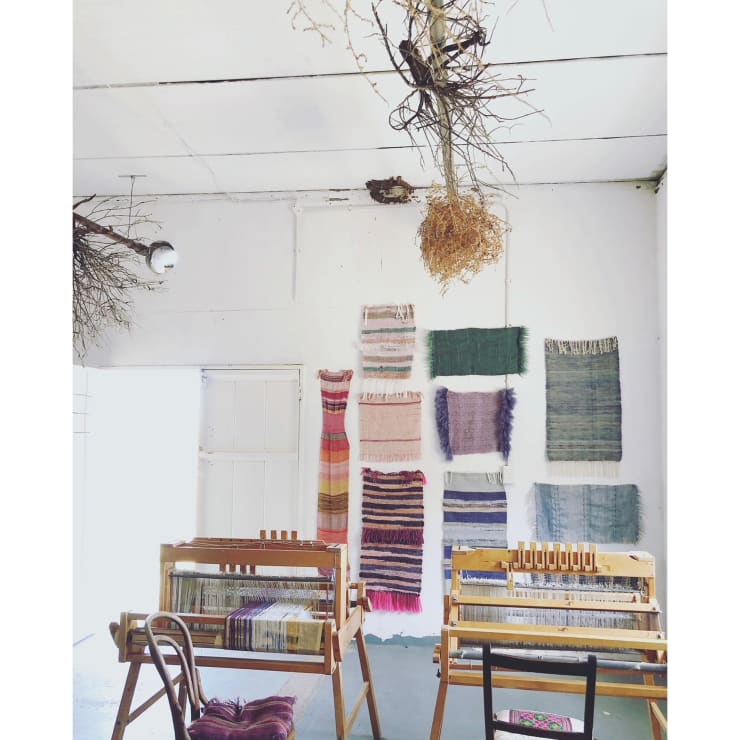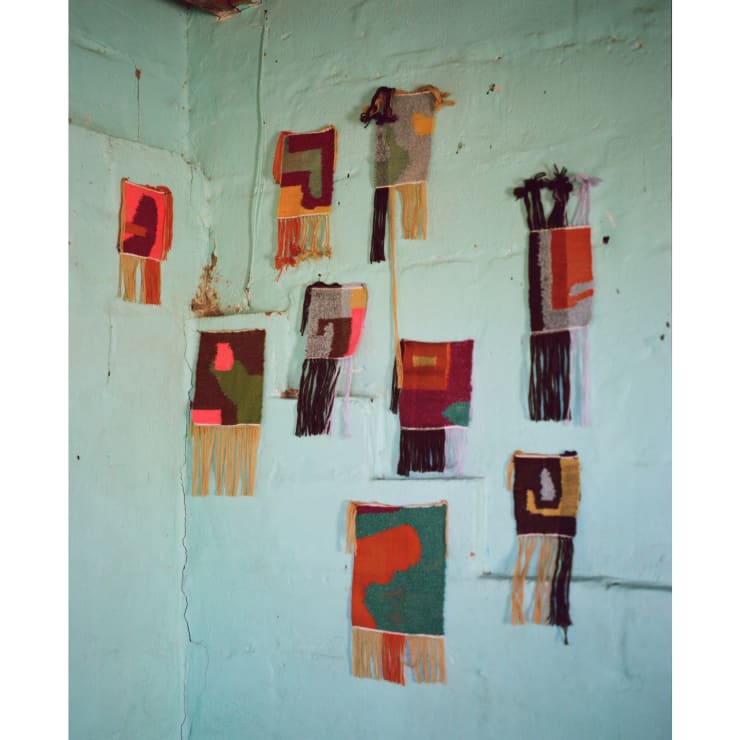Frances van Hasselt is a designer and entrepreneur focusing on mohair textiles in South Africa. She collaborates with a team of women artisans in the Karoo, weaving a story about the origins of textiles, simultaneously allowing the natural environment to inform every aspect of their design and making process.
Raised on a mohair farm in the Karoo desert, van Hasselt has a deep affinity for this natural fibre. She has spent the last several years–after working in the fashion and textile industries in Hong Kong and South Africa–developing a business designed to elevate mohair to amore prominent status as one of the world’s most ancient, exclusive fibres.
To acquire knowledge and technical insight into ways to work with mohair, van Hasselt spent time abroad in various textile centres (most notably, residencies in Japan and Italy).
Her role in creating an inclusive, sustainable supply chain specifically adapted to the eco-system of the South African textile industry earned her a Mandela Washington Fellowship. Her studies (a bachelor’s degree in Political Science, Philosophy and Economics from the University of Stellenbosch and a post graduate degree in International Relations at The University of Cape Town) ensure that the story of her work is considered and rooted in history and context. Her work for Kate Otten Architects, ‘Threads’ was on show at the 2023 Venice Biennale.
OTOMYS: You live in the Karoo in South Africa; an area defined by its topography, geology, cloudless skies and extremes of heat and cold … many would simply define this as a a desert. Tell us about life in the area and how this rhythm and sense of place informs your textile art.
Frances VH: Taking our design inspiration from the Karoo, where nature is the defining element, informs every aspect of what we create. The simplicity and perfection of nature’s effortless composition, tactility and colouring is consistently the greatest and most humbling teacher.
The Karoo strips me back to what I can only describe as ‘the mesmerising simple’; there is nothing to distract one from the light, the scorch of a midday sun and the impossible quest of a dung beetle rolling life’s shit into a treasured ball of soul-defining importance. The Karoo humbles; making us feel tiny in its antiquity and yet offers a blank slate to translate what you feel into shapes and stories that only you can imagine. This feeling of being a fleeting spec in space is matched with a sense of enormous privilege and ‘bigness’ – Knowing that you could be the only person to have seen a tiny pop of purple in a passing desert plant. You look again, and the light has shifted, the flower is closed, and everything has returned to a ‘nothing to see here’ kind of dull. A moment so small is mesmerising in its simplicity.
In our studio we prioritise time to play; exploring new colours, textures, shapes, and stitch lines. Through our fabrics we attempt to capture the essence of this place, its people, its history and our personal relationship with its tortoises and mountain folds.
The Karoo is home to mohair the world over and what is interesting is that the fibre reflects the landscape from which it originates. Karoo mohair is textured, soft, full of natural lustre and character, unexpected twists and the gift of being able to absorb and capture colour. To celebrate this fibre, the land and the hands that piece our textiles together, texture and form is fundamental. In our work the irregularity of the yarns and weave conveys the subtle shifts and changes of the Karoo’s vast horizons.
OTOMYS: South Africa contributes significantly to the global supply of raw mohair, what are the supply chains on this product once it leaves your farm? What is it about raw mohair that speaks to you.
Frances VH: Up to 60% of the world’s mohair is produced in South Africa; specifically in the Karoo: A semi-arid area of the country. This is where my family farm with Angora Goats and where we have our textile studio.
Mohair is one of the only natural fibres with a supply so small and the fibre so delicate, so almost all the world’s raw mohair is sent to South Africa to be processed – It has become this global centre of raw mohair production and processing. 80% of global supply leaves the country in a raw form, with little being done locally to benefit the raw material and grow the local textiles industry.
For mohair to be celebrated locally and to be recognized as the home to mohair the world over, we need to start producing excellent end pieces which celebrate its incredible properties and unique African heritage. It was with a circular supply chain in mind that I started my mohair studio to create unique local mohair textiles.
‘Family Hold Back’ is a series of textile art woven from a mixture of incredible mohair yarns made by spinners in South Africa and mixed with hand-spun yarns made in our studio.
Our mohair comes directly from the farm; it is hand washed, sun dried, opened by hand and then hand spun – I could talk about spinning and natural fibre for the longest time. This process of working with raw, natural fibre in it’s place of origin, holding its true character, mixed with nothing other than natural elements and human touch gives our work an inexplicable feel, rawness.
As each strand of mohair is fed into the spinning wheel it captures the mood of the maker. We can tell in the studio whose yarn is whose and whether that spinner is having a good or bad day, if they are angry, in love, happy, tired. All these thoughts and feelings are picked up in the rhythm of their spinning and the way the artisan moves her hands over the fibre. Every section of the yarn and woven fabric encapsulates the hands of the crafts people, the Karoo heat and curl.
OTOMYS: You have spoken of your 'community of weavers’; this social aspect to your practice is interesting, can you tell us how a community contributes to a series of work?
Frances VH: We built our studio focussing on the strengths and over-looked skills that are unique to the socio-economic and environmental make-up of South Africa’s textile industry; We have the best mohair in the world, produced under the most sustainable practices, some of the only processing houses of mohair and even though we don’t have a formal textile sector we have thousands of highly skilled, predominantly women, artisans. When you combine these elements with cutting edge design and quality, we are now producing pieces that hold their own on a world stage.
Once you understand the impact and power of working within a unique ecological and social footprint you can make even the tiniest output outstanding and capture the attention and imagination of those looking for authenticity, beauty, storytelling and above all a truth.
Our studio is made up of phenomenal women artisans; our pieces are very much an outcome of a conversation between artist, maker and threads. The full process starts with rain, the delicate eco system of the Karoo plant life, the quality of the ground, the role of herdsmen and the importance of healthy animals to produce quality mohair. From raw fibre we move into the process of washing, cleaning, dyeing, and spinning until finally the yarn ends up on the loom. In many ways weaving and finishing is the last few steps on an intricate and co-dependent supply chain.
Once we understand the connectivity between us and nature and all the actors and skills needed to get from farm to fabric you make differently, you think differently, you do not need more, you are selective and respectful of the timelessness of that piece.
OTOMYS: We are launching your textile art in Australia with a series of small mohair tapestries called The Family Hold Back series. This series of hand woven mohair characters is as much about the craftsmanship of creating expressive works as it is about your perception of people and places. Your quirky humour is evident in the titles of each work and of course by the way their hair lies on each character. What is the process for you as an artist once you have an idea such as this?
Frances VH: In this collection textiles are seen as more than simply fabrics, here they are on the wall as portraits of families and friends, a series of wonky woven characters. There is nothing complex and intimidating about them, instead they are relaxed and open to making a fool of themselves so as to encourage viewers to feel free to laugh and talk without judgement. Once you engage with textiles as an artform you open the door to seeing the workings of these threads; the warp and the weft meeting and mixing yarns into textures, forms and feelings that can move and shift with the light.
Our wish for ‘Family Hold Back’ is to do the total opposite, the phrase itself implies that they have already overshot the mark and are well on their way to being inappropriate.
We hope that you recognize a little bit of yourself in these works placed on the wall, asking you to listen to their stories and relate to that inexplicable umbilical thread that binds our collective humanness.
Met liefde van die Karoo
X
March 20, 2024























